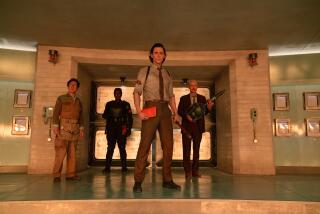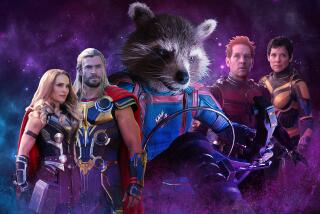‘Loki’ Episode 4 introduces some surprising new characters. Here’s the backstory
This story contains spoilers for Episode 4 of “Loki” on Disney+.
A man can die but once — unless you’re Loki.
Things looked pretty dire for the Time Variance Authority’s most-wanted Loki variants as they faced an imminent apocalypse, but the fourth episode of the Marvel Studios series, titled “The Nexus Event,” proves that you shouldn’t underestimate any version of the god of mischief.
It seems that Loki (Tom Hiddleston) and Sylvie (Sophia Di Martino) getting to know each other has led to the former developing some romantic feelings for the latter, adding a new twist to that age-old adage about learning to love yourself before being able to love anybody else.
With twisted timelines and character “variants,” Marvel’s adventure can be hard to keep straight. Here’s an episode-by-episode guide to help you out.
That possibly timeline-shattering development is just one of the many turns taken in this episode of “Loki,” which sees the facade of the TVA and the Time Keepers start to crumble in the face of Sylvie’s revelations. All that leaves plenty of questions for the remaining two episodes of the season to resolve.
But the “Loki” team left the episode’s biggest reveal for the post-credits scene.
It turns out that Loki, who was “pruned” by none other than Judge Ravonna Renslayer (Gugu Mbatha-Raw) earlier in the episode, has not been vaporized as viewers were led to believe. Instead, he wakes up in some grass and wonders aloud if he is dead.
“Not yet,” says a mysterious voice. “But you will be unless you come with us.”
The “us” mentioned? Four different versions of Loki. Here’s a brief rundown of their comic-book backstories.
Is that Old Man Loki?
One new version of Loki glimpsed in the scene — which appears to take place in some post-apocalyptic New York if the crumbled buildings are any indication — is portrayed by Richard E. Grant. In the credits, the character is referred to as “Classic Loki.”
Classic Loki’s look resembles the design of the character in the comics as drawn by Jack Kirby (who co-created Loki along with Stan Lee and Larry Lieber). Making his official debut in the ‘60s, comic book Loki was originally a more straightforward villain than the sympathetic anti-hero he has evolved into in more recent depictions.
This Loki, who had a fierce, jealous grudge against his brother Thor and kept plotting to take him down, even came to be known as the God of Evil for his cruel actions. Visually, he was portrayed as older and more slight than the recent redesigns.
A version of Loki that more closely resembles this past evil incarnation was the villain in the 2014-15 “Loki: Agent of Asgard” comic book series, which saw a younger Loki trying to atone for his past misdeeds. The older Loki of this series, however, was revealed to be a future version of the character (called King Loki) who had returned to his more evil ways.
To be hired for the Disney+ series, starring Tom Hiddleston as the god of mischief, the director knew she had to impress. And her plan worked.
There’s a Kid Loki?
There is, and he is a fan favorite. Jack Veal’s character is described in the “Loki” credits as “Kid Loki,” and his look seems inspired by the comic book version of the character.
As Hiddleston’s Loki mentions in the episode, Loki doesn’t often stay dead when people try to kill him.
In the comics, Kid Loki is a reincarnation of Loki, who died trying to defend Asgard after turning on the bad guys. This younger Loki has lesser powers than adult Loki and no memories of his past self.
Kid Loki is not at all evil and even develops a good relationship with his brother Thor. But of course, this doesn’t last. In order to save the world, Kid Loki lets the spirit of his past, older self kill him and take over his body — though his personality remains as a sort of conscience to pester this other self.
In a 2013 comic series, Kid Loki plays a part in reassembling the Young Avengers before aging up a bit. A number of Young Avengers have already been introduced in the Marvel Cinematic Universe — including “WandaVision” twins Billy and Tommy, “The Falcon and the Winter Soldier’s” Eli and “Ant-Man’s” Cassie Lang. Others, including Kate Bishop and America Chavez, are slated to be introduced in the near future (in “Hawkeye” and “Doctor Strange in the Multiverse of Madness,” respectively).
What about the Loki with a hammer?
The Loki portrayed by DeObia Oparei is described in the credits as “Boastful Loki,” and there does not seem to be an obvious comic book counterpart to his character.
Boastful Loki appears to be armed with a hammer, however, so perhaps it is a version of Loki that is a bit more Thor-like. There have been occasions in the comics where Loki is able to lift Thor’s hammer Mjolnir, which can only be wielded by those deemed “worthy.”
Can you explain Alligator Loki?
Loki is a shapeshifter, and his power isn’t limited to transforming into other humans. While Alligator Loki does not appear to originate in the comics, Loki has been shown to shape-shift into animals or even animal versions of other characters, like the time he turned into Cat Thor. (Note: I have not independently confirmed Alligator Loki is an alligator. He could be a crocodile. But I think he looks more like an alligator.)
Speaking of Thor, Loki did turn his brother into a frog once in the comics, which led to a brief “Frog Thor” storyline in the ‘80s. In this story, Frog Thor meets another worthy frog, revealed to be a former human, who eventually becomes a character known as Throg.
For now, we can only hope Alligator Loki’s appearance will set up a future adventure with Frog Thor and Spider-Ham (the pig version of Spider-Man, as seen in comics and “Spider-Man: Into the Spider-Verse”).
More to Read
The complete guide to home viewing
Get Screen Gab for everything about the TV shows and streaming movies everyone’s talking about.
You may occasionally receive promotional content from the Los Angeles Times.







